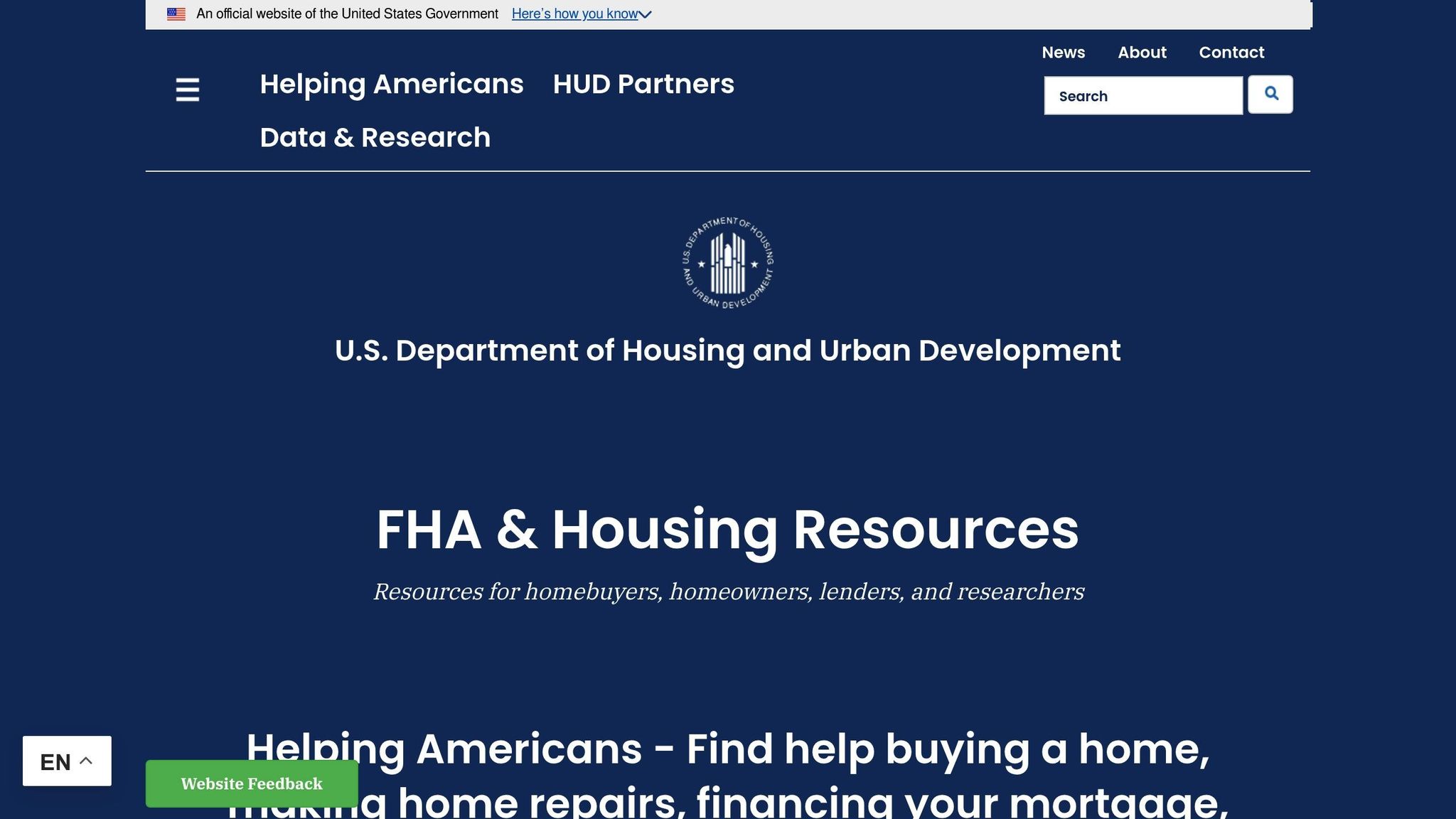The FHA Streamline Refinance program in 2025 is a refinancing option designed for homeowners with existing FHA loans. Its primary goal is to simplify the refinancing process while helping borrowers reduce monthly payments or secure better loan terms. Here’s what you need to know:
- Who Qualifies: Current FHA borrowers with a solid payment history (no more than one late payment in the past 12 months) and at least six consecutive on-time payments after a 210-day waiting period.
- Key Benefits: Lower interest rates, reduced monthly payments, and the option to switch from an adjustable-rate to a fixed-rate mortgage.
- Requirements:
- The refinance must provide a net tangible benefit, such as a 0.50% reduction in interest rate.
- No new property appraisal or income verification is typically needed.
- Closing costs cannot be added to the new loan balance.
- Limitations: Cash-out refinancing is capped at $500, and mortgage insurance premiums (UFMIP and MIP) are still required.
- Options: Borrowers can choose between non-credit qualifying (no credit or income checks) or credit-qualifying paths (requires credit and income review).
This program is ideal for those looking for a straightforward refinancing process without extensive paperwork. However, it’s not suitable for borrowers seeking to access significant home equity or eliminate mortgage insurance.
FHA Streamline Refinance Explained (2025)
FHA Streamline Refinance Eligibility Requirements for 2025
Knowing the requirements for an FHA Streamline Refinance can help you decide if this program suits your needs. While the criteria are more relaxed compared to traditional refinancing, there are still key qualifications to meet.
Basic Eligibility Requirements
To qualify, you must already have an FHA-insured mortgage and maintain a solid payment history. Only FHA-insured mortgages are eligible for this program [3].
Your mortgage must be current, with no more than one late payment in the past 12 months. Additionally, you need to have made six consecutive on-time payments after a 210-day waiting period [2].
The refinance must also offer a net tangible benefit, typically defined as reducing your interest rate by at least 0.50% [2]. Alternatively, switching from an adjustable-rate mortgage to a fixed-rate mortgage can qualify, even if the interest rate change is smaller [2].
"Streamline refinance refers to the refinance of an existing FHA-insured mortgage requiring limited borrower credit documentation and underwriting." – HUD.gov [3]
Documentation requirements are straightforward. You’ll need to submit a loan application, recent payment history, and minimal documents like bank and utility bills to confirm your residence and financial stability [2].
Program Restrictions and Limits
Even if you meet the eligibility criteria, there are restrictions and limitations to keep in mind. For starters, cash-out refinancing is not permitted, though you can receive up to $500 cash back at closing [2][3].
Closing costs cannot be added to your new loan balance [2]. This means you’ll need to pay these costs out of pocket, which could be a significant expense depending on your loan and local fees [3].
"FHA does not allow lenders to include closing costs in the new mortgage amount of a streamline refinance." – HUD.gov [3]
Lenders may impose stricter requirements than FHA’s minimums [2]. For example, some lenders might require higher credit scores or additional documentation beyond what FHA guidelines specify.
Lastly, mortgage insurance is still required with streamline refinancing. Expect to pay an Upfront Mortgage Insurance Premium (UFMIP) of 1.75% of the loan amount, which will be added to your loan balance [2]. You’ll also pay an Annual Mortgage Insurance Premium (MIP) of 0.55%, divided into monthly payments [2].
For 2025, FHA loan limits range from $524,225 to $1,209,750, depending on your location [5]. These limits set the maximum loan amount eligible for FHA programs, including streamline refinancing.
Program Features and Application Process
Building on the eligibility criteria mentioned earlier, the FHA Streamline Refinance program is designed to simplify and speed up the refinancing process by reducing paperwork and eliminating unnecessary steps.
Non-Credit Qualifying vs. Credit-Qualifying Options
The FHA Streamline Refinance program offers two distinct paths: non-credit qualifying and credit-qualifying. Each option caters to different borrower needs.
With the non-credit qualifying option, lenders typically skip credit score and income evaluations. This can be especially appealing if you’ve faced challenges like job loss, reduced income, or a drop in your credit score since taking out your original FHA loan.
On the other hand, the credit-qualifying option requires a review of your credit score and debt-to-income ratio. This path is often necessary when making changes like adding or removing a co-borrower. It can also be a good choice if your financial situation has improved, as it might allow you to secure a better interest rate.
| Feature | Non-Credit Qualifying | Credit-Qualifying |
|---|---|---|
| Credit Score Check | Not required for approval | Required |
| Income Verification | Not required | Required |
| Best For | Borrowers with stable or lower credit | Borrowers with stronger credit profiles |
| Required When | Standard refinancing | Adding or removing co-borrowers |
Both options are designed to minimize the hassle, with reduced documentation requirements making the process even smoother.
Reduced Documentation Requirements
A key benefit of the FHA Streamline Refinance program is its focus on simplicity. Borrowers typically don’t need a new appraisal, which saves both time and money. Income verification is often unnecessary as well, meaning you can skip the hassle of gathering pay stubs, tax returns, or employment letters.
The documentation required is usually limited to your loan application, proof of recent mortgage payments, and minimal additional paperwork. It’s also worth noting that the interest rates for FHA Streamline Refinances are in line with standard FHA purchase rates, so you won’t face higher rates for the convenience of reduced documentation.
Another advantage is the potential for a mortgage insurance refund. Borrowers may receive up to 68% of their prepaid mortgage insurance as an MIP discount, offering meaningful savings [2].
The application process is straightforward: begin by reaching out to FHA-approved lenders to compare rates and terms. Once you choose a lender, the reduced documentation requirements help speed up the underwriting process, making refinancing faster and easier.
sbb-itb-8115fc4
2025 Program Updates and Market Trends
The FHA Streamline Refinance program continues to adapt to changing market conditions and regulatory shifts, giving borrowers the tools they need to make smarter refinancing decisions.
Program Rule Changes for 2025
The core requirements for the FHA Streamline Refinance program remain steady, ensuring it stays accessible to existing FHA borrowers. However, there are some notable updates for 2025. Non-permanent residents are no longer eligible for FHA-insured mortgages [10]. Additionally, the program’s net tangible benefit test now requires at least a 0.50% reduction in the interest rate, and cash-out funds are capped at $500 [2][3]. These changes reflect evolving regulations that influence how borrowers approach refinancing.
Current Market Conditions and Borrower Impact
Interest rate trends play a major role in the appeal of FHA Streamline Refinance options. As of July 17, 2025, the average interest rate for a 30-year fixed-rate mortgage was 6.75% [8], while FHA refinance rates in April 2025 averaged 5.80% [7]. With rates remaining higher than in previous years, borrower behavior has shifted. For example, 82.8% of homeowners with mortgages had rates below 6% by the third quarter of 2024 [6]. The Congressional Budget Office predicts that rates will stay elevated through 2024 but could start to decline in 2025 and 2026 [9]. If this forecast holds, FHA Streamline Refinance activity may pick up as rates fall.
FHA loans continue to serve borrowers facing unique financial challenges. Mason Whitehead, a branch manager for Churchill Mortgage in Dallas, highlights one key advantage:
"FHA allows you to qualify much faster with significant credit events than a conventional loan does." [7]
FHA refinances currently make up 11.23% of all refinance mortgages in the U.S. [11], underscoring the program’s importance. For borrowers with unstable or reduced income, the non-credit qualifying option can be especially appealing since it skips traditional income verification [11]. That said, it’s still critical for borrowers to ensure they can manage the new mortgage payments, even with the simplified documentation process.
The annual mortgage insurance premium for FHA loans remains at 0.55% [2]. However, as Whitehead points out, FHA mortgage insurance can be pricier compared to conventional loans:
"Monthly mortgage insurance with FHA is generally more expensive than with a conventional loan because it is a fixed rate no matter your credit score. So, a borrower with a 740 credit score putting 5% down on a conventional loan may only have a monthly mortgage insurance rate of 0.25%, whereas the same loan-to-value with FHA will be 0.55%." [7]
Even with higher mortgage insurance costs, FHA loans often offer lower interest rates than conventional loans [7], which can help offset the difference. Another perk is the potential for borrowers to receive up to 68% of their prepaid mortgage insurance back as a discount on the new loan’s mortgage insurance premium (MIP) [2].
FHA Streamline Refinance Pros and Cons
If you’re an existing FHA borrower, the FHA Streamline Refinance program offers a straightforward way to lower your interest rate or monthly payments. But like any financial product, it comes with its own set of advantages and limitations. Here’s a closer look at what makes this program appealing – and where it might fall short.
Benefits vs Drawbacks Comparison
One of the standout features of the FHA Streamline Refinance is its simplified qualification process. Dan Green, a contributor to The Mortgage Reports, explains:
"The FHA Streamline is a ‘low-doc’ refinance with limited paperwork required. The lender doesn’t have to verify your income or credit, and there’s no home appraisal. That means a Streamline Refinance closes faster than other loans and has slightly cheaper closing costs." [2]
This streamlined approach makes it an attractive option for borrowers whose financial circumstances may have shifted since they took out their original loan. It’s also a lifeline for homeowners with underwater mortgages – situations where traditional refinancing options might not work.
There are also financial perks for eligible borrowers. For instance, if your loan was originated before March 2023, you might qualify for a reduced mortgage insurance premium (MIP) rate. This could lead to additional savings over time.
However, the program isn’t without its drawbacks. One major limitation is the inability to pull cash from your home equity, which makes it unsuitable for homeowners needing funds for large expenses or debt consolidation.
| FHA Streamline Refinance Pros | FHA Streamline Refinance Cons |
|---|---|
| Easier qualification process, including non-credit qualifying options | No ability to withdraw significant cash from home equity |
| Opportunity to lock in lower interest rates | Some lenders may require a minimum credit score |
| Potential for reduced MIP rates for certain borrowers | Loan term cannot be shortened |
| No home appraisal required | Closing costs cannot be added to the loan balance |
While the program offers faster processing and lower closing costs compared to other refinancing options, it’s worth noting that upfront fees can’t be rolled into the loan. Borrowers should expect closing costs to range from 2% to 5% of the loan amount – about $3,000 to $7,500 on a $150,000 mortgage. Additionally, there’s an upfront mortgage insurance premium of 1.75% of the loan balance.
Eligibility criteria further narrow the program’s appeal. Only current FHA borrowers can apply, and they must have made at least six on-time payments while waiting 210 days since their last purchase or refinance. Late payments automatically disqualify applicants, and some lenders may impose additional credit score requirements [2].
Josh Steppling, a real estate broker associate with eXp Realty in Stuart, Florida, underscores the program’s value for the right candidates:
"An FHA streamline refinance is an excellent option for homeowners with existing FHA loans." [12]
For borrowers looking to simplify the refinancing process and reduce monthly payments without extensive paperwork, this program can be a smart choice. However, if you’re hoping to access significant equity or eliminate mortgage insurance entirely, conventional refinancing might better suit your needs.
Conclusion
The FHA Streamline Refinance continues to stand out as one of the most straightforward refinancing options for homeowners with FHA loans in 2025. Depending on where you live, loan limits for this program range from $524,225 to $1,209,750 [4][13].
One of the program’s biggest appeals is its simplified process with minimal paperwork. However, as HUD clarifies, “Streamline refinance refers only to the amount of documentation and underwriting that the lender must perform, and does not mean that there are no costs involved in the transaction” [1]. This transparency ensures borrowers have realistic expectations.
For eligible homeowners, this refinancing option can lead to notable financial savings. Borrowers who qualify may benefit from reduced mortgage insurance premiums, which can make a significant difference over time.
Whether or not this program is right for you depends on your financial goals. If you’re aiming to lower your interest rate without dealing with extensive paperwork – and you’ve made at least six on-time payments over the last 210 days – this could be a simple solution. On the other hand, if you’re looking to access cash or remove mortgage insurance, a conventional refinance might be a better fit.
To make the most of this opportunity, compare current FHA refinance rates, estimate your potential monthly savings, and check if you qualify for reduced MIP rates, especially if your original loan was issued before March 2023 [2].
FAQs
What’s the difference between non-credit qualifying and credit-qualifying FHA Streamline Refinance options in 2025, and how do I decide which is right for me?
In 2025, the FHA Streamline Refinance program provides two key options to suit different borrower needs:
- Non-Credit Qualifying: This path skips the credit check and income verification, making it a straightforward choice for those with lower credit scores or limited financial documentation.
- Credit-Qualifying: This option involves a credit check and proof of income. While it requires more paperwork, it could help you secure better terms – like a lower interest rate – if you have a strong credit profile.
Choosing between these options depends on your financial priorities. If your credit has improved or you’re focused on long-term savings, the credit-qualifying option might be the way to go. On the other hand, if you value speed and simplicity, or if your credit and income present challenges, the non-credit qualifying option may be more suitable.
What is the net tangible benefit requirement for an FHA Streamline Refinance, and how can it be met?
The net tangible benefit rule is in place to make sure that refinancing through an FHA Streamline Refinance genuinely improves your financial situation. This could mean reducing your interest rate by at least 0.5%, cutting your monthly mortgage payment by at least 5%, or switching from an adjustable-rate mortgage (ARM) to a fixed-rate loan.
For instance, if your current loan carries a high interest rate, refinancing to a lower rate could lead to significant savings over time. Likewise, moving from an ARM to a fixed-rate mortgage can offer more stability and consistency in your monthly payments. These adjustments are designed to ensure that refinancing works in your favor.
What are some effective ways to reduce closing costs for an FHA Streamline Refinance in 2025?
If you’re looking to cut down on closing costs for an FHA Streamline Refinance in 2025, one option is to negotiate with your lender. Some lenders may agree to cover these costs or allow you to roll them into your loan balance. Another approach could involve slightly increasing your interest rate to offset the fees.
Closing costs usually fall between 2% and 6% of the loan amount, making it a significant expense worth addressing. Be sure to carefully review your loan estimate to spot any fees that seem unnecessary or unclear. If something doesn’t add up, don’t hesitate to ask your lender for clarification or dispute the charges.
Related posts








